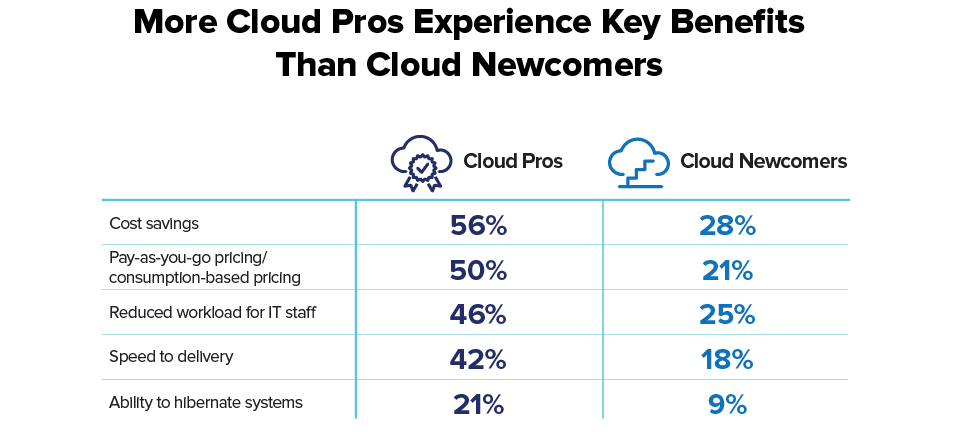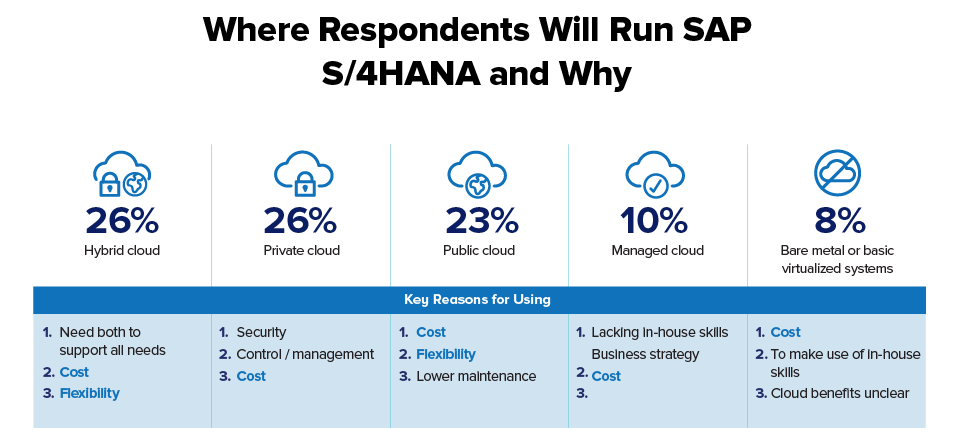Understanding cloud adoption among SAP customers is often ignored and undervalued for its strengths in guiding future cloud strategy. For the past four years, Syntax has partnered with ASUG to investigate SAP customers’ cloud processes and spending habits. And each year, we’ve found that cloud adoption has hovered between 80 and 90%. In fact, 80% of 2020 respondents currently use cloud services and this number will only continue to grow.
Our understanding of SAP users has shifted as we’ve tested and analyzed cloud misconceptions, barriers, and spending. We’ve identified key trends in our past several reports by comparing year-over-year data from real customers. Here’s what we found:
- In 2017, Syntax and ASUG challenged misconceptions about the cloud, including IT burdens and downtime.
- In 2018, Syntax and ASUG defined barriers to implementation and challenges with the cloud.
- In 2019, Syntax and ASUG investigated shifts in SAP customer cloud spending.
- In 2020, Syntax and ASUG looked at driving forces behind shifts in cloud architecture and drivers of satisfaction.
Between cloud distribution models, service offerings, and cost savings, there’s often a lack of understanding about how SAP users are spending their cloud budgets. By surveying 71 SAP users in March 2020 about their cloud usage and spending, we’ve captured key insights. SAP customers have quickly pivoted short- and long-term cloud strategies to respond to new challenges related to COVID-19. Businesses newer to cloud can use these insights to avoid potential pitfalls and architect cloud strategies moving forward.
5 important data points for tech leaders investing in cloud
SAP users must consider the following data points when planning their next cloud spend.
1. SAP customers increasingly see the value of their cloud investments
Budget limitations caused by the pandemic have not deterred SAP users from investing in cloud, and investments above one million dollars have increased each year. Our survey found that while 20% of respondents in 2018 and 26% in 2019 planned to spend over a million dollars on cloud, 35% plan to do so this year. Companies are also moving more workloads to the cloud than in 2019, with the majority (74%) of respondents using platforms as a service (PaaS).
As businesses adjust to remote work, cloud solutions have become increasingly critical to maintaining workloads. Respondents cited scalable workloads and reduced IT workloads as the top two benefits to cloud, two business challenges that will come to a head as companies look to IT to drive higher value innovation initiatives. Expect global cloud spending to increase as more users invest: Of those not currently using cloud services, 63% say they are considering implementing them.
2. SAP cloud newcomers should learn from the successes and failures of SAP cloud pros
The majority of respondents (67%) to our survey were what we called SAP cloud pros or companies that have used the cloud for three to five years. The survey found that, in general, the longer a company has used cloud, the greater share of key benefits, such as cost savings, reduced IT workload and speed to delivery, they receive. Over time, cloud services handle more work and become more effective.
But SAP cloud newcomers shouldn’t fret. By paying attention to the successes and failures of the SAP cloud pros before them, SAP cloud novices have an opportunity to avoid similar missteps and reap the benefits of cloud more quickly. While cloud newcomers may experience pain points during initial adoption, following in leaders’ footsteps and continuing to expand current programs can fast track their journey to cloud maturity.

3. Hybrid and multi-cloud increase, but more users are turning to private cloud in light of security concerns
Like in past years, we’ve seen steady growth in hybrid cloud users, jumping from 51% of respondents in 2019 to 59% in 2020. Similarly, those using multiple cloud providers increased significantly from 65% in 2019 to 82% in 2020. Users cite flexibility and the ability to support all needs as top reasons for deploying multi-cloud strategies. In fact, almost half of respondents (48%) use two or three cloud providers to run their workloads.
Interestingly, most respondents who currently use a single provider opt for the private cloud, while those using multiple providers opt for hybrid cloud. This may be because although public cloud providers have been around for more than 10 years now, SAP customers have been generally slower to adopt a public cloud strategy for their SAP-specific workloads. Instead, many have used a private cloud provider as a way to bridge the gap between on-premises and public cloud. But as the data shows, a good number of SAP customers have fully embraced public cloud and are, in fact, looking at multiple providers to run both SAP and non-SAP workloads in a true hybrid cloud to better utilize the advantages of each cloud.
In general, the private cloud seems to be experiencing a resurgence. In 2019, only 22% of respondents said they used private cloud, which is a long way from the 48% who report using it this year. COVID-19 could be responsible in part for the shift to private cloud solutions as remote work demands more comprehensive data privacy solutions. More than a quarter of respondents already live on S/4 HANA (26%) pointed to security as the top reason why they use private cloud to run S/4 HANA, while others cited cost and the ability to control the environment in-house. With hackers taking advantage of rushed transition processes, leaders must keep security top of mind through the investment of any new software.
4. Many SAP customers hope to implement SAP S/4HANA soon
Although the deadline to migrate to S/4HANA — SAP’s latest ERP that runs entirely on the HANA database — is a few years away, many companies are making the switch well before 2027. Users increasingly see value in implementing SAP S/4HANA systems, citing increased business value and consistent performance. Currently, 38% of respondents say they are on SAP S/4HANA, while 46% are still in the process of moving or making plans — a gap we expect to decrease year over year as more companies take on this monolithic migration.
The largest share of respondents who already live on SAP S/4HANA are part of organizations with greater than five billion dollars in annual revenue, implying cost may be a prohibitive factor to implementation. Cloud newcomers are also more likely than cloud pros to already live on S/4HANA, opting for hybrid applications due to cost and flexibility needs. Foregoing the traditional and lengthy migration from SAP error-correcting code (ECC) and starting with S/4HANA may allow cloud newcomers to more quickly gain competitive advantage once held by more digitally mature peers.

5. As public cloud awareness grows, we expect to see more replatforming
We define replatforming as optimizing workloads and applications with base cloud functionalities and cost optimizations during a cloud migration. And though respondents who were familiar with the concept said they were interested in replatforming, about one third (31%) said they had never heard of the term before. To nearly a third (27%), it means “using a cloud migration as an opportunity to move from one cloud host to another,” while to others (15%) it means “moving from on-premise to the cloud.”
However, despite the confusion, there is some agreement on the benefits of replatforming. Almost 1 in 2 (46%) respondents indicated they are using the move to SAP S/4HANA to replatform, citing reasons like cost savings, reducing customizations, and taking advantage of new technology and processes. Of this group, cloud newcomers were more likely to say they will use their S/4HANA migration as an opportunity to replatform (53%) than their SAP cloud pro counterparts (46%), likely to reap these benefits more quickly.
Make the most out of your cloud services
Regardless of cloud spend or type of deployment, organizations with cohesive and comprehensive strategies are most likely to perceive benefits and advance cloud deployment. You don’t need to start with a million-dollar budget for cloud spending to benefit from solutions. Begin by migrating small workflows on specific teams, then determine how you might scale solutions or seek outside experts like Syntax for assistance. No matter how experienced you are as an SAP customer, all cloud users can benefit from the right partner helping them create a long-term road to success.
Learn more about how SAP customers are moving to the cloud
Download the Syntax-ASUGU 2020 cloud survey whitepaper to learn more about SAP cloud pros and newcomers.
You can also download the Syntax-ASUG whitepapers from the past three years where we:
- debunked cloud myths in 2017
- discovered new cloud challenges in 2018
- learned how SAP customers accelerate their cloud transformation in 2019

